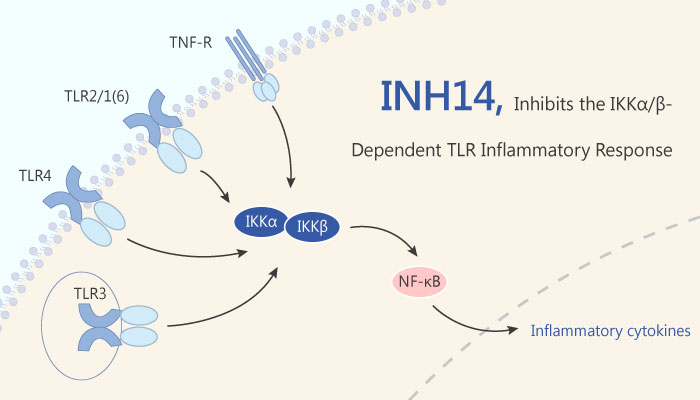Toll-like receptors (TLRs) are a class of proteins important in innate immune system. The members of TLRs are TLR1, TLR2, TLR3, TLR4, TLR5, TLR6, TLR7, TLR8, TLR9, TLR10, TLR11, TLR12, and TLR13. So far, TLR11, TLR12, and TLR13 have not been found in humans. TLRs involve in activation of transcription factors such as NF-κB. The latter induces the cytokines and chemokines. Theses activate the adaptive immune system. A potent inhibitor of TLR becomes a need to suppress the inflammatory response. INH14 is a potent inhibitor of IKKα and IKKβ. It decreases the pro-inflammatory response induced by IKK-dependent TLRs, IL-1R and TNF-R by inhibiting IKKα/β.
In order to find out the potency of INH14, researchers started a couple of steps.

Firstly, they tried to discover the target of INH14. In cellular assay, INH14 dose-dependently attenuated TLR2-mediated NF-κB activity with an IC50 of 4.127 µM. In HEK293 cells, the inhibitor blocked TNFα and IL-1 signaling. In RAW264.7 mouse macrophages and human monocytes, INH14 (15 µM) suppressed the production of TNFα after TLR2 or TLR4 stimulation. Furthermore, the compound prevented downstream of TAK1/TAB1 but showed no inhibitory activity against AP-1 activation.
Then, after a series of experiments, researchers finally found out the targets of INH14. They are IKKα and IKKβ. INH14 potently inhibits IKKα and IKKβ, with IC50s of 8.97 and 3.59 μM, respectively.
Subsequently, in the in vivo assay, C57BL/6J mice were treated with 5 µg/g of INH14 by intraperitoneal injection. The IKKα/β inhibitor INH14 reduced the lipopeptide-induced inflammation in animals.
In summary, INH14 is a potent IKKα/β inhibitor, reduces TLR2/TLR4/TNF-R/IL-1R signaling by targeting the two receptors. It also shows anti-inflammatory activity in mice. More study should be carried out to explore the potential of INH14.
Reference:
Chembiochem. 2019 Mar 1;20(5):710-717.